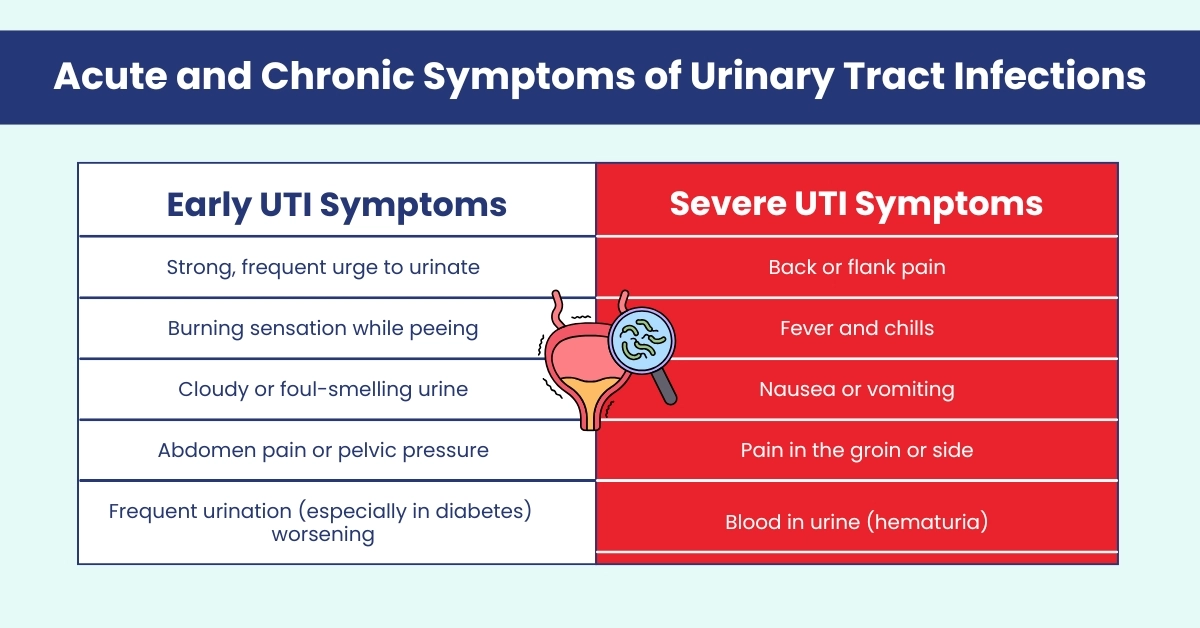Table of content
- Types of Urinary Tract Infections: Their Locations and Causes
- Connection Between Diabetes and UTI
- Psoriasin Deficiency Due to Diabetes:
- UTI Without Bacteria: Pyuria
- Diabetes and UTI in Females
- Acute and Chronic Symptoms of Urinary Tract Infections
- Dangerous UTI Complications in Diabetics
- Prevention of UTI in Diabetics
- Diabetic Urinary Tract Infection Treatment
- Lifestyle Choices During UTI
- Confirm It’s a UTI — Not Something Worse
- Final Thoughts
- Frequently Asked Questions
Diabetics have irregular levels of sugar in their bloodstream, ultimately leading to a weak immune system. Urinary tract infections (UTIs), except for pyuria, are caused by bacteria. High blood sugar in your bloodstream promotes faster bacterial growth, and a weak immune system cannot fight it effectively. Hence, people with diabetes are more susceptible to getting this health condition, and that too of severe intensity due to their weak immune system.
According to Nationwide Children’s Hospital, people with diabetes are up to 10 times more likely to develop a UTI, with women at higher risk compared to men because of the smaller urethral tube.
Types of Urinary Tract Infections: Their Locations and Causes
A urinary tract infection (UTI) occurs when microbes invade and multiply anywhere along the urinary tract — including the urethra, bladder, ureters, or kidneys.
| Type of UTI | Location | Cause |
| Urethritis | Urethra | Bacteria from stool (e.g., E. coli), sexual activity |
| Cystitis | Bladder | Bacterial migration from urethra |
| Pyelonephritis | Kidneys | Untreated lower UTI spreading upwards |
| Ureteritis | Ureters | Rare; secondary to kidney/bladder infection |
Connection Between Diabetes and UTI
The link between diabetes and UTI in females and males is well-established:
- High blood sugar creates a favorable environment for bacterial growth.
- Weakened immunity reduces the body’s ability to fight infections.
- Diabetes urinary complications such as nerve damage, slow bladder emptying — increase infection risk.
- Frequent urination diabetes patients allows bacteria to ascend the urinary tract.

Psoriasin Deficiency Due to Diabetes:
A 2022 article in Medical News Today noted that diabetes may reduce levels of psoriasin — a natural antimicrobial protein in the bladder lining. Low psoriasin makes it easier for bacteria to colonize, increasing the risk of recurrent UTI in diabetes.
Still using fingersticks?
You may be eligible to claim a continuous glucose monitor (CGM), such as Freestyle Libre 2 Plus sensors, from CGM Monitors, using your insurance. These sensors allow you to monitor your blood sugar 24/7, without even pricking your fingers, and make informed decisions to keep your sugar in control.
UTI Without Bacteria: Pyuria
Pyuria refers to white blood cells in urine without detectable bacteria. It’s often due to:
- Previous antibiotic use
- Kidney stones or inflammation
- Diabetes bladder infection with fastidious organisms
- Viral or fungal infections (Candida in particular in diabetics)
Diabetes and UTI in Females
According to Dr. Robin Barry of Medical News Today, women with diabetes face a higher risk of urinary tract infections (UTIs) and recurrence due to high blood sugar, weakened immunity, and urinary tract changes. In men with diabetes, the risk is lower, about a quarter, but often linked to additional conditions such as prostate enlargement. Maintaining good blood glucose control, practicing proper urinary hygiene, and promptly treating infections are key preventive strategies for both men and women.
Research highlights that in pregnant women without diabetes, the prevalence of symptomatic UTI ranges from ~3% to 10.1%. In contrast, among pregnant women with diabetes, the prevalence can reach up to ~27.6%. It is due to elevated glucose and hormonal changes during pregnancy. If you want to know more about diabetes gestational diabetes, then read on.
Acute and Chronic Symptoms of Urinary Tract Infections
A study shared by PubMed suggests that upon testing UTIs in diabetic and non-diabetic patients, diabetics were found to have higher fever with painful urination, often with a burning sensation, while the other symptoms remained the same.
When uncertain of UTI, you may need to watch out for:
Early UTI Symptoms:
- Strong, frequent urge to urinate
- Burning sensation while peeing
- Cloudy or foul-smelling urine
- Abdomen pain or pelvic pressure
- Frequent urination (diabetes) worsening
Severe UTI Symptoms (Complications):
- Back or flank pain
- Fever and chills
- Nausea or vomiting
- Pain in the groin (area where abdomen meets upper thigh) or side
- Blood in urine (hematuria)
Dangerous UTI Complications in Diabetics
Some infections require urgent medical attention:
| Condition | Details | Why Dangerous |
| Pyelonephritis | Infection reaches kidneys | May cause sepsis or kidney failure |
| Emphysematous cystitis | Gas-producing bacteria infect bladder (more common in diabetics) | Life-threatening; needs hospitalization |
| Fungal UTI (Candida) | Common in poorly controlled diabetes | Often recurrent and drug-resistant |
| Perinephric abscess | Pus collection around kidneys | Requires drainage and IV antibiotics |
Prevention of UTI in Diabetics
Prevention of UTI in diabetics is key to reducing recurrence and complications:
- Control blood sugar: Tight glucose control lowers bacterial growth. You can use a CGM device like Dexcom G7 or FreeStyle Libre 3 Plus.
- Hydrate well: Dilutes urine and flushes bacteria.
- Don’t hold urine: Empty bladder regularly.
- Hygiene: Wipe front to back, especially for diabetic women and UTIs risk reduction.
- Post-sex urination: Reduces bacterial entry.
- Wear breathable underwear: Prevents moisture buildup.
- Avoid unnecessary antibiotics: They disturb protective microbiota.
Diabetic Urinary Tract Infection Treatment
Treatment depends on infection type and severity. Never make a medical decision without consulting a doctor.
Common Medications:
| Drug | Use |
| Nitrofurantoin | Uncomplicated lower UTI |
| Trimethoprim-sulfamethoxazole (TMP-SMX) | First-line UTI therapy |
| Fosfomycin | Single-dose option for cystitis |
| Ciprofloxacin / Levofloxacin | Complicated UTI / pyelonephritis |
| Fluconazole / Amphotericin B | Fungal UTI |
Always complete the full course of antibiotics — stopping early can lead to recurrent infection or resistance.
Important: According to a study shared by PubMed, UTI patients who received vaginal ovules containing Lactobacillus spp. following antimicrobial treatment, were found with a recurrence rate of 21% only.
Lifestyle Choices During UTI
- Sexual activity: It’s best to pause sexual intercourse until the infection clears to avoid worsening irritation and spreading bacteria.
- Diet: Limit sugar and processed foods to prevent fueling bacterial growth.
- Probiotics: May help restore healthy urinary flora. While Lactobacillus strains are found to create an acidic environment, limiting bacterial crowding, yogurt may also be beneficial.
Confirm It’s a UTI — Not Something Worse
Don’t ignore persistent symptoms. Ensure your doctor rules out:
- Emphysematous cystitis
- Pyelonephritis
- Fungal infections (Candida)
- Kidney abscesses
Untreated, these conditions can lead to sepsis or permanent kidney damage.
Final Thoughts
Upon noticing even the slightest symptoms of UTI, see a Doctor. Start with a urologist. If infections are recurrent, severe, or involve the kidneys, you’ll likely be referred to a nephrologist.
Seek emergency care if you have a fever, back pain, vomiting, or blood in your urine. While this health condition is common, urinary tract infections in diabetics are often more severe and recurrent compared to non-diabetics.
Careful blood sugar control, early diagnosis, and prompt treatment are critical. Always take UTI symptoms in diabetes seriously, and remember, timely care can prevent life-threatening complications.
Frequently Asked Questions
Can high blood sugar cause urinary infections?
While not directly, high sugar in your blood allows faster bacterial growth, plus diabetes weakens your immune system, making it incapable of fighting bacteria properly.
What’s the difference between a yeast infection vs UTI in diabetes?
UTI (urinary tract infections) typically occur in the urinary tract, with even the bacteria entering from the urethral tube, whereas a yeast infection occurs differently and affects different areas, usually warm and moist, e.g., vaginal, penis, groin, under the breasts, mouth, mouth corners, or nail beds. Moreover, a yeast infection causes itching, discharge, and redness, while a UTI causes burning urination, frequency, and sometimes fever. Both conditions are common in diabetics.







Write a comment
Your email address will not be published. All fields are required